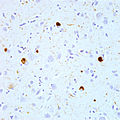Dementia with Lewy bodies: Difference between revisions
No edit summary |
CSV import |
||
| Line 63: | Line 63: | ||
[[Category:Dementia]] | [[Category:Dementia]] | ||
{{stub}} | {{stub}} | ||
<gallery> | |||
File:Lewy_body_in_the_substantia_nigra_from_a_person_with_Parkinson's_disease.jpg|Dementia with Lewy bodies | |||
File:Haloperidol_(Haldol).jpg|Dementia with Lewy bodies | |||
File:ApoE_22k_fragment_2001.png|Dementia with Lewy bodies | |||
File:Immunostaining_(brown)_of_alpha-synuclein_in_Lewy_Bodies_and_Lewy_Neurites_in_the_neocortex_of_a_patient_with_Lewy_Body_Disease.jpg|Dementia with Lewy bodies | |||
File:CSIRO_ScienceImage_9370_Amyloid_beta_plaque_in_the_brain_follows_specific_patterns_as_detected_by_CSIROs_analysis_technique_from_PiB_PET_scans_here_an_AIBL_volunteer_is_receiving_a_PiB_PET_scan.jpg|Dementia with Lewy bodies | |||
File:Polysomnography_connections.jpg|Dementia with Lewy bodies | |||
File:FDG_Alzheimer_Disease_and_Dementia_with_Lewy_Bodies.jpg|Dementia with Lewy bodies | |||
File:Surface_FDG_Alzheimer_Disease_and_Dementia_with_Lewy_Bodies.jpg|Dementia with Lewy bodies | |||
File:Robin_Williams_Happy_Feet_premiere.jpg|Dementia with Lewy bodies | |||
File:CC-BY_icon.svg|Dementia with Lewy bodies | |||
</gallery> | |||
Latest revision as of 11:50, 18 February 2025
| Dementia with Lewy bodies | |
|---|---|

| |
| Synonyms | Diffuse Lewy body disease, dementia due to Lewy body disease |
| Pronounce | N/A |
| Field | Neurology, psychiatry |
| Symptoms | Dementia, abnormal behavior during REM sleep, fluctuations in alertness, visual hallucinations, parkinsonism |
| Complications | |
| Onset | After the age of 50, median 76 |
| Duration | Long term |
| Types | N/A |
| Causes | Unknown |
| Risks | |
| Diagnosis | Based on symptoms and biomarkers |
| Differential diagnosis | Alzheimer's, Parkinson's disease dementia, certain mental illnesses, vascular dementia |
| Prevention | |
| Treatment | |
| Medication | Donepezil, rivastigmine and memantine; melatonin |
| Prognosis | Variable; average survival 4 years from diagnosis |
| Frequency | About 0.4% of persons older than 65 |
| Deaths | |
Dementia with Lewy bodies (DLB) is a type of dementia that is associated with the build-up of a protein called alpha-synuclein in the brain. It is the third most common cause of dementia, after Alzheimer's disease and vascular dementia, accounting for 10-15% of all cases.
Signs and Symptoms[edit]
Individuals with DLB may exhibit a range of symptoms, including:
Cognitive impairment Fluctuating attention Recurrent visual hallucinations Parkinsonism DLB frequently presents with significant neuropsychiatric symptoms, including hallucinations and delusions. In some cases, these symptoms may precede the onset of cognitive decline.
Causes[edit]
The exact cause of DLB is unknown. The condition is characterized by the presence of Lewy bodies, which are abnormal aggregates of protein that develop inside nerve cells, impairing their function.
Diagnosis[edit]
The diagnosis of DLB is often challenging, as it shares symptoms with several other conditions, including Alzheimer's disease and Parkinson's disease. Diagnosis typically involves a thorough medical history, physical examination, cognitive testing, and brain scans.
Treatment[edit]
There is currently no cure for DLB. Treatment focuses on managing symptoms and may include medications such as cholinesterase inhibitors, antipsychotics, and levodopa.
Prognosis[edit]
The prognosis for DLB is poor, with a life expectancy of 5-8 years after the onset of symptoms.
Epidemiology[edit]
DLB is the third most common cause of dementia, accounting for 10-15% of all cases. The condition most commonly affects individuals between the ages of 50 and 85.
See Also[edit]
References[edit]
<references>
<references group="" responsive="0"></references>
External links[edit]
Dementia with Lewy bodies at Curlie
Dementia with Lewy bodies at Curlie
Lewy Body Dementia Association
|
|
|
-
Dementia with Lewy bodies
-
Dementia with Lewy bodies
-
Dementia with Lewy bodies
-
Dementia with Lewy bodies
-
Dementia with Lewy bodies
-
Dementia with Lewy bodies
-
Dementia with Lewy bodies
-
Dementia with Lewy bodies
-
Dementia with Lewy bodies
-
Dementia with Lewy bodies









